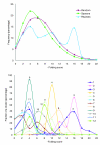Evolutionary conservation of sequence and secondary structures in CRISPR repeats
- PMID: 17442114
- PMCID: PMC1896005
- DOI: 10.1186/gb-2007-8-4-r61
Evolutionary conservation of sequence and secondary structures in CRISPR repeats
Abstract
Background: Clustered regularly interspaced short palindromic repeats (CRISPRs) are a novel class of direct repeats, separated by unique spacer sequences of similar length, that are present in approximately 40% of bacterial and most archaeal genomes analyzed to date. More than 40 gene families, called CRISPR-associated sequences (CASs), appear in conjunction with these repeats and are thought to be involved in the propagation and functioning of CRISPRs. It has been recently shown that CRISPR provides acquired resistance against viruses in prokaryotes.
Results: Here we analyze CRISPR repeats identified in 195 microbial genomes and show that they can be organized into multiple clusters based on sequence similarity. Some of the clusters present stable, highly conserved RNA secondary structures, while others lack detectable structures. Stable secondary structures exhibit multiple compensatory base changes in the stem region, indicating evolutionary and functional conservation.
Conclusion: We show that the repeat-based classification corresponds to, and expands upon, a previously reported CAS gene-based classification, including specific relationships between CRISPR and CAS subtypes.
Figures



References
-
- Mojica FJ, Ferrer C, Juez G, Rodriguez-Valera F. Long stretches of short tandem repeats are present in the largest replicons of the Archaea Haloferax mediterranei and Haloferax volcanii and could be involved in replicon partitioning. Mol Microbiol. 1995;17:85–93. doi: 10.1111/j.1365-2958.1995.mmi_17010085.x. - DOI - PubMed
Publication types
MeSH terms
Substances
LinkOut - more resources
Full Text Sources
Other Literature Sources
Molecular Biology Databases

